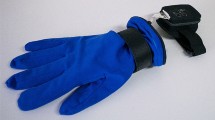Abstract
This article presents the results of a study on the classification of 36 letters of the Polish Sign Alphabet (PSL) using a data glove. The data glove includes a Raspberry Pi, a PCB with four 16-bit ADS1115 ADCs, and ten piezoresistive sensors. The sensors function as potentiometers that respond to finger bending. A neural network consisting of LSTM and convolutional layers was used for classification, achieving an efficiency of 99% on data from a single subject, which underwent prior augmentation. The study suggests that the device could potentially be calibrated solely from the target user. This is the first study of its kind on PSL.
Access this chapter
Tax calculation will be finalised at checkout
Purchases are for personal use only
Similar content being viewed by others
References
U. Nations, “International Day of Sign Languages | United Nations,” Nations, United. 2021. [Online]. Available: https://www.un.org/en/observances/sign-languages-day
“What are the different types of sign language?,” Sign Solutions. 2021. [Online]. Available: https://www.signsolutions.uk.com/what-are-the-different-types-of-sign-language/
Geers, A.E., Mitchell, C.M., Warner-Czyz, A., Wang, N.-Y., Eisenberg, L.S. (2017) Early sign language exposure and cochlear implantation benefits. Pediatrics 140(1). doi: https://doi.org/10.1542/peds.2016-3489
NCDHHS (2021) Assistive Technology for the Deaf and Hard of Hearing
What Is American Sign Language (ASL)? | NIDCD (2023) Mar. 2019. https://www.nidcd.nih.gov/health/american-sign-language (accessed Feb. 21, 2023)
Do, N. T., Kim, S. H., Yang, H. J., Lee, G. S.: Robust hand shape features for dynamic hand gesture recognition using multi-level feature LSTM. Appl. Sci. 10(18). doi: https://doi.org/10.3390/APP10186293
Hill, J.: Do deaf communities actually want sign language gloves? Nat. Electron. 3(9), 512–513 (2020). https://doi.org/10.1038/s41928-020-0451-7
Saeed, Z. R., Zainol, Z. B., Zaidan, B. B., Alamoodi, A. H.: A systematic review on systems-based sensory gloves for sign language pattern recognition: an update from 2017 to 2022. IEEE Access 1–1, 2022, doi: https://doi.org/10.1109/ACCESS.2022.3219430
Lee, M., Bae, J.: Deep learning based real-time recognition of dynamic finger gestures using a data glove. IEEE Access 8, 219923–219933 (2020). https://doi.org/10.1109/ACCESS.2020.3039401
Lee, M., Bae, J.: real-time gesture recognition in the view of repeating characteristics of sign languages. IEEE Trans. Ind. Informatics 18(12), 8818–8828 (2022). https://doi.org/10.1109/TII.2022.3152214
Piskozub, J.: Rozpoznawanie gestów statycznych ręki za pomocą rękawicy sensorowej. PRZEGLĄD ELEKTROTECHNICZNY 1(9), 144–147 (2019). https://doi.org/10.15199/48.2019.09.29
Wen, T., Keyes, R.: Time series anomaly detection using convolutional neural networks and transfer learning. Accessed: Mar. 06, 2023. [Online]. Available: https://www.fast.ai
Bengio, Y., Simard, P., Frasconi, P.: Learning long-term dependencies with gradient descent is difficult. IEEE Trans. Neural Networks 5(2), 157–166 (1994). https://doi.org/10.1109/72.279181
Hochreiter, S., Schmidhuber, J.: Long short-term memory. Neural Comput. 9(8), 1735–1780 (1997). https://doi.org/10.1162/neco.1997.9.8.1735
Chung, J., Gulcehre, C., Cho, K., Bengio, Y.: Empirical evaluation of gated recurrent neural networks on sequence modeling (2014). doi: https://doi.org/10.48550/arXiv.1412.3555
Author information
Authors and Affiliations
Corresponding author
Editor information
Editors and Affiliations
Rights and permissions
Copyright information
© 2024 The Author(s), under exclusive license to Springer Nature Switzerland AG
About this paper
Cite this paper
Piskozub, J., Strumiłło, P. (2024). Data Glove for the Recognition of the Letters of the Polish Sign Language Alphabet. In: Strumiłło, P., Klepaczko, A., Strzelecki, M., Bociąga, D. (eds) The Latest Developments and Challenges in Biomedical Engineering. PCBEE 2023. Lecture Notes in Networks and Systems, vol 746. Springer, Cham. https://doi.org/10.1007/978-3-031-38430-1_27
Download citation
DOI: https://doi.org/10.1007/978-3-031-38430-1_27
Published:
Publisher Name: Springer, Cham
Print ISBN: 978-3-031-38429-5
Online ISBN: 978-3-031-38430-1
eBook Packages: EngineeringEngineering (R0)




